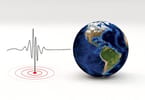Another large storm is poised to roll into the West with rain, snow and travel disruptions during the second week of November.
According to AccuWeather Senior Meteorologist Ken Clark, “There is more good news on the way for part of the drought-stricken West starting this weekend and into next week.”
“A new storm from the Pacific Ocean will spread rain and snow as far south as California and as far east as Colorado, Wyoming and Montana,” Clark said.
The storm will continue to build the snowpack in the high country and soak the soil at lower elevations of the West.
It will follow the first widespread mountain snow of the season in the West, with totals of 1 to 2 feet of snow on part of the Sierra Nevada, Colorado Rockies and portions of northern Nevada, this week.
The Pacific storm, which will arrive this weekend, will first send a moderate amount of rain southward along the coasts of Washington, Oregon and northern California during Friday night and Saturday. A soaking is in store for Seattle, Portland, Oregon, and Crescent City, California.
During Saturday into Monday, the storm will strengthen and move southward along the coast, rounds of rain will ramp up and expand inland, while snow levels will lower from north to south over the Cascades.
The high country in the Cascades could pick up 6-12 inches of snow from the storm. Snow is likely to reach down to the passes in Washington and Oregon. Slushy areas may develop along Interstate 90 through Snoqualmie Pass.
The most likely time for drenching rain and travel delays in San Francisco and Sacramento, California, is on Monday. Gusty winds may also affect the coast of northern California at this time.
The heaviest snow will focus on central and northern Sierra Nevada on Monday into Tuesday. Snowfall in the high country in this area could exceed a foot. Accumulating snow is likely to extend to Donner Pass.
The storm will turn inland over the West Monday into Wednesday.
“How far south, how much snow falls and how low snow levels get over the Sierra Nevada, upper part of the Great Basin and northern and central Rockies will depend on the track of the storm and how much moisture is available,” Clark said.
“There is the potential for some locations to be hit with similar or perhaps greater snowfall, when compared to the storm this week, especially north of Southern California, Arizona and New Mexico,” Clark said.
For cities such as Los Angeles, Las Vegas and Phoenix, it is a bit too early to say for sure whether the storm will bring significant rain or not next week.
More snow will fall farther north across the interior West next week, when compared to this week’s storm. In addition to parts of I-80 in Nevada and Wyoming and I-70 in Colorado, the storm next week is likely to bring significant wintry impacts and potential travel disruptions along I-90 from the Bitterroot Range to the Black Hills.
Salt Lake City will get a another chance at snow on Tuesday.
There is a chance that enough snow falls to cover roads in the Denver metro area Tuesday night into Wednesday. More significant cold air is likely to sweep southward along the Front Range during the middle of next week, which will support more snow. While snow fell in Denver on Thursday, it generally melted on roads.
The same storm could evolve into a blizzard over part of the northern Plains as it pushes east of the Rockies on Wednesday. People traveling along I-80 in Nebraska and I-90 in South Dakota will want to monitor the progress of the storm.
WHAT TO TAKE AWAY FROM THIS ARTICLE:
- It will follow the first widespread mountain snow of the season in the West, with totals of 1 to 2 feet of snow on part of the Sierra Nevada, Colorado Rockies and portions of northern Nevada, this week.
- In addition to parts of I-80 in Nevada and Wyoming and I-70 in Colorado, the storm next week is likely to bring significant wintry impacts and potential travel disruptions along I-90 from the Bitterroot Range to the Black Hills.
- “How far south, how much snow falls and how low snow levels get over the Sierra Nevada, upper part of the Great Basin and northern and central Rockies will depend on the track of the storm and how much moisture is available,”.






















